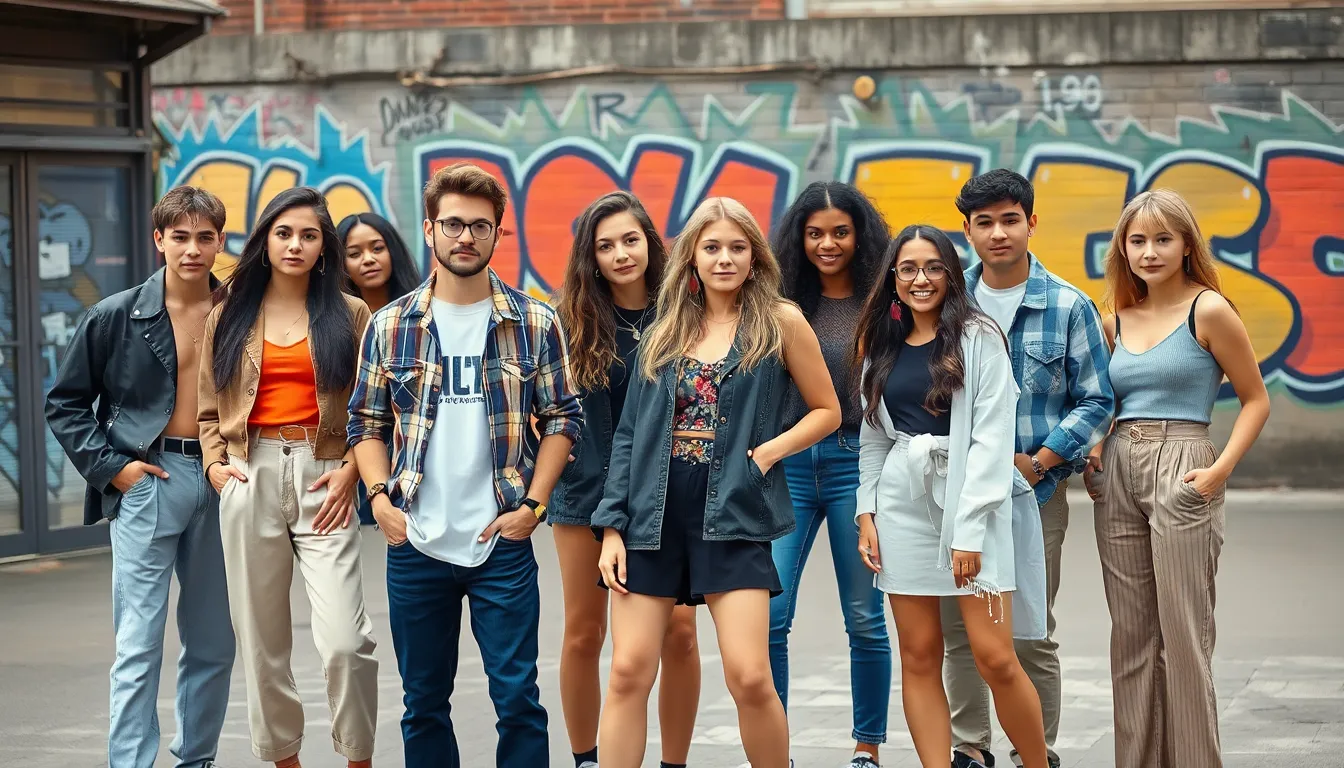Table of Contents
ToggleUnisex fashion is shaking up wardrobes everywhere, proving that style knows no gender. Gone are the days when clothing was strictly categorized—today, it’s all about breaking boundaries and embracing versatility. This trend isn’t just a passing fad; it’s a revolution that invites everyone to express themselves without the constraints of traditional fashion norms.
Overview of Unisex Fashion
Unisex fashion represents a significant shift in how people approach clothing. This style promotes inclusivity and allows for personal expression beyond traditional gendered norms. Designers increasingly create collections that blur the lines between men’s and women’s attire, prioritizing versatility and comfort.
The growth of unisex fashion corresponds with societal changes that embrace individuality. Many consumers gravitate towards pieces that suit various occasions, providing options for all body types. Clothing such as oversized t-shirts, tailored joggers, and relaxed-fit outerwear often forms the backbone of unisex wardrobes.
Markets reflect this trend, with major brands launching unisex lines and smaller designers focusing on gender-neutral collections. Retailers report increased demand for items that cater to diverse audiences. Data shows that over 70% of millennials support brands that promote gender inclusivity in fashion.
In addition to aesthetic appeal, unisex designs prioritize functionality and quality. Materials used range from sustainable fabrics to innovative textiles, aligning with the growing awareness of environmental issues. Consumers often seek out items that are durable and timeless, reducing the need for constant wardrobe updates.
Cultural influences also play a role in the rise of unisex fashion. Music, art, and social movements inspire collections, reflecting broader conversations about identity. Events such as fashion shows and festivals serve as platforms where unisex fashion gains visibility and recognition.
Overall, unisex fashion continues to evolve, shaping not only individual wardrobes but also the fashion industry as a whole. The trend marks a progressive step toward more inclusive and varied expression in clothing choices.
Evolution of Unisex Fashion

Unisex fashion has developed significantly over the years, marking a pivotal point in clothing and personal expression. This evolution reflects changing societal attitudes towards gender and individuality.
Historical Context
Unisex fashion traces its roots back to the 1960s when cultural revolutions challenged traditional gender norms. Designers like Yves Saint Laurent introduced iconic pieces, such as the women’s tuxedo, which blurred the lines between men’s and women’s wear. The 1980s brought mainstream attention with androgynous models and music icons promoting a gender-fluid aesthetic. In subsequent decades, the emergence of LGBTQ+ rights movements further encouraged fashion diversity, prompting designers and brands to embrace inclusive collections. The transition from strictly defined gender categories in fashion began, laying the foundation for today’s unisex styles.
Modern Influences
Modern influences play a crucial role in shaping unisex fashion today. Globalization has allowed designers to draw inspiration from various cultures, creating eclectic, inclusive clothing options. Social media platforms have also contributed, enabling individuals to share their unique styles and connect with like-minded communities. Sustainable fashion practices have gained traction, with many brands incorporating eco-friendly materials into gender-neutral designs. The support from millennials—over 70% express approval for brands embracing gender inclusivity—demonstrates a growing desire for versatile, functional clothing that transcends traditional labels. Events such as fashion shows and festivals amplify visibility, reinforcing the ongoing evolution of unisex fashion.
Key Characteristics of Unisex Fashion
Unisex fashion is defined by several core characteristics that prioritize inclusivity and adaptability in clothing.
Gender-Neutral Designs
Gender-neutral designs feature silhouettes and styles that appeal to all genders. Designers often utilize neutral colors, oversized fits, and non-conforming patterns. Collections typically emphasize ease of wear, allowing individuals to mix and match items without societal constraints. Notably, brands targeting unisex markets adhere to creating visual aesthetics that move beyond traditional categorizations. Clothing items often possess functionality rather than fitting strictly within men’s or women’s wardrobes.
Versatility and Comfort
Versatility and comfort rank high among the priorities for unisex fashion. Pieces commonly transition seamlessly from day to night, catering to diverse settings and occasions. Fabrics like cotton, linen, and modal enhance comfort while accommodating various body types. Layering becomes essential, enabling individuals to style their outfits according to personal preferences. Styles inspired by streetwear trends offer relaxed looks that appeal to a wide audience. Overall, unisex fashion embraces flexible designs that make dressing easier and more enjoyable.
Popular Unisex Brands
Unisex fashion features a variety of brands that cater to diverse tastes and preferences. Notable designers and trendsetting labels play a pivotal role in promoting this inclusive movement.
Notable Designers
Yves Saint Laurent revolutionized fashion in the 1960s by introducing iconic pieces that blurred traditional gender lines. Designers like Rick Owens and Thom Browne continue this legacy by creating collections that embrace fluidity. They prioritize comfort, often using unique cuts and innovative materials. Additionally, brands like Telfar champion unisex clothing, fostering an inclusive environment. Telfar’s bags, known as “Bushwick Birkin,” emphasize accessibility and appeal to all.
Trendsetting Labels
A variety of labels have become synonymous with unisex styles. Brands such as Acne Studios and Comme des Garçons focus on gender-neutral designs that attract a broad audience. Each collection showcases silhouettes and colors appealing to everyone, regardless of gender. Patagonia and Reigning Champ emphasize sustainability alongside inclusivity, using eco-friendly materials in their production. Unisex fashion thrives as these trendsetting labels push boundaries, reinforcing that style transcends gender.
Cultural Impact of Unisex Fashion
Unisex fashion significantly influences societal norms and gender perceptions.
Societal Acceptance
Societal acceptance of unisex fashion reflects broader cultural shifts. Individuals increasingly embrace the freedom to wear what aligns with their identity. Around 70% of millennials actively seek brands promoting gender inclusivity, showcasing a strong desire for diverse fashion options. Popularity continues to grow as brands respond with inclusive collections, showing that unisex styles resonate across various demographics. Retailers see increased consumer interest, indicating a shift from traditional views toward more accepting attitudes regarding clothing choices. Designers understand this need, producing pieces that foster comfort, personal expression, and broad appeal.
Influence on Gender Norms
Unisex fashion actively reshapes gender norms within society. Traditional boundaries continue to blur as individuals explore styles beyond conventional categories. Designers embrace this fluidity, contributing to a growing recognition that clothing isn’t strictly defined by gender. Cultural icons and influencers champion the movement, amplifying its reach and acceptance. This change inspires others to express themselves authentically, promoting diversity and inclusivity in wardrobe choices. By challenging outdated perceptions, unisex fashion encourages individuals to define style on their own terms, paving the way for a more inclusive fashion landscape.
Unisex fashion is more than just a trend; it’s a movement that redefines how people express themselves through clothing. As traditional gender norms continue to fade, individuals are empowered to choose styles that resonate with their unique identities.
This shift not only fosters inclusivity but also encourages creativity in personal style. With designers actively embracing gender-neutral designs, the fashion landscape is evolving to meet the diverse needs of consumers.
As unisex fashion gains traction, it’s clear that the future holds exciting possibilities for self-expression and acceptance in the world of apparel. The journey toward a more inclusive fashion industry is just beginning, and its impact will be felt for years to come.



